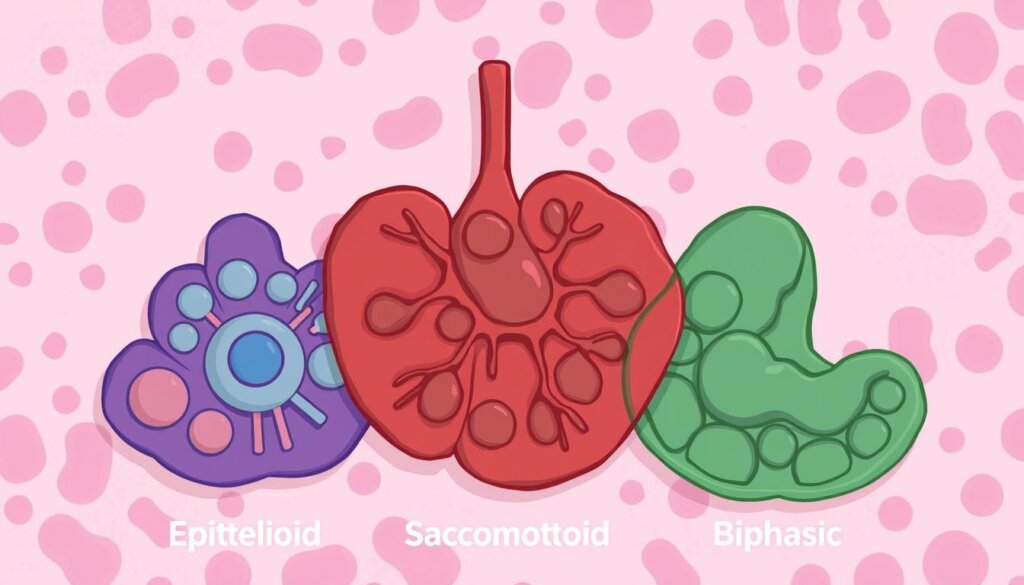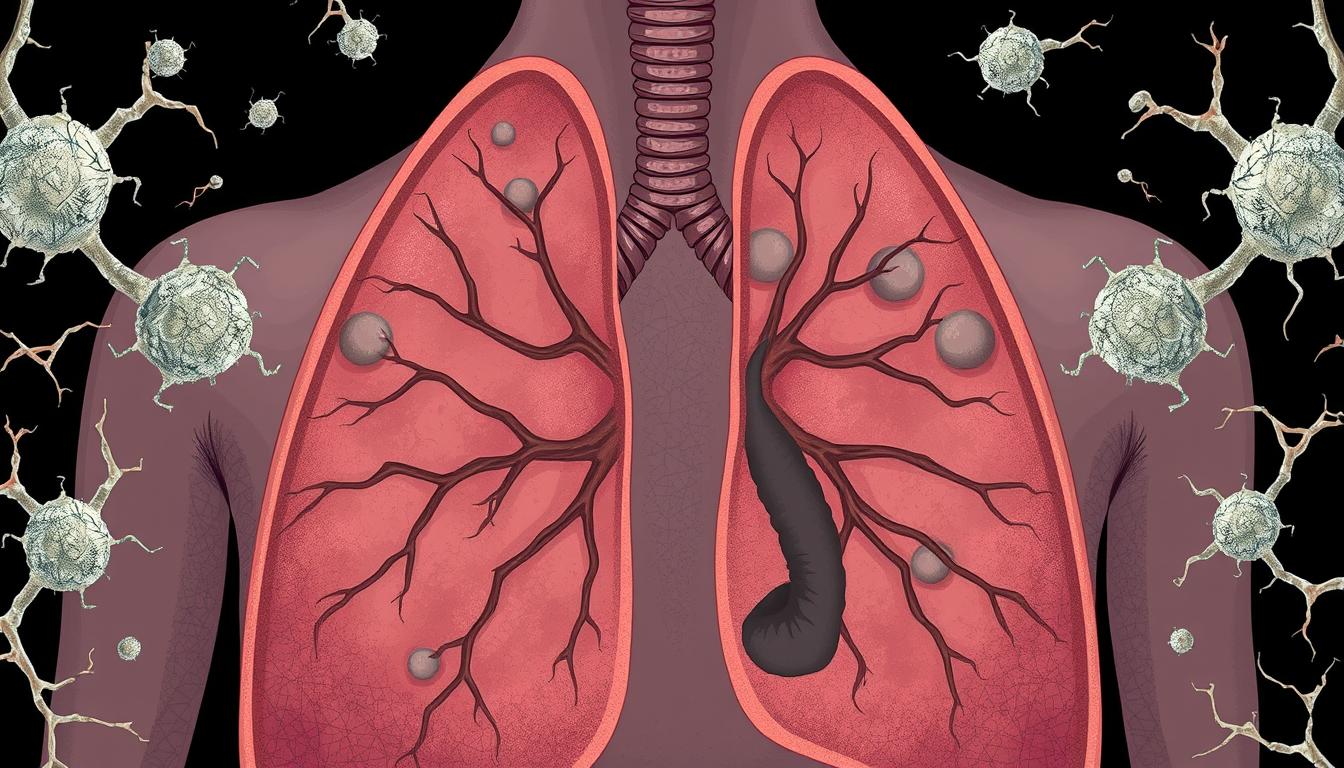FTC disclaimer: This post may contains affiliate links and we will be compensated if you click on a link and make a purchase.
Mesothelioma is a rare and aggressive cancer that kills about 3,000 Americans each year. It mainly affects the pleura, the thin layer around the lungs. Pleural mesothelioma makes up 70% to 79% of all cases. Asbestos exposure is the main risk factor, but not everyone exposed to asbestos gets the disease. This shows other factors might play a role.
Mesothelioma can also affect the peritoneum, pericardium, and tunica vaginalis, but these are rarer. Symptoms include chest pain, shortness of breath, and unexplained weight loss. Early diagnosis is key. Treatment like surgery and chemotherapy can help, but the disease is still very serious. Compensation and legal assistance may be available for those affected.
Key Takeaways
- Mesothelioma is a rare and aggressive form of cancer that primarily affects the pleura, or the lining of the lungs.
- Asbestos exposure is the primary risk factor for mesothelioma, but most people with asbestos exposure never develop the disease.
- Mesothelioma can also develop in the abdomen, heart, and testicles, but these types are much rarer.
- Symptoms vary based on the location of the cancer and may include chest pain, shortness of breath, and unexplained weight loss.
- Early diagnosis is crucial, as treatment options such as surgery, chemotherapy, and radiation therapy can help improve outcomes, though the prognosis remains poor.
What is Mesothelioma?
Mesothelioma is a rare and aggressive cancer. It develops in the mesothelium, a thin layer of tissue. This tissue lines and protects many internal organs. The most common form is pleural mesothelioma, which affects the lungs’ lining. Other forms can occur in the abdomen, heart, or testicles.
Types of Mesothelioma
Pleural mesothelioma is the most common form, making up most cases. But, there are other types too. Peritoneal mesothelioma affects the abdominal lining. Pericardial mesothelioma develops in the heart sac. And, mesothelioma of the tunica vaginalis affects the testicular lining.
Prevalence and Statistics
Mesothelioma is rare, with about 3,000 new cases in the U.S. each year. It mainly affects older adults, with an average age at diagnosis of 72. Eight out of 10 people with mesothelioma were exposed to asbestos.
The number of cases has been going down since the early 1990s. This is likely because there is less asbestos in workplaces. But, deaths from mesothelioma in women have gone up, with 614 in 2020.
While it mainly hits men, women are also affected. Many women with mesothelioma worked in healthcare or were homemakers of asbestos-exposed spouses.

“Mesothelioma is a rare cancer that forms in the thin tissue that lines many internal organs.”
Causes of Mesothelioma
Mesothelioma is a rare and aggressive cancer caused by asbestos. Asbestos is a mineral used in the past in many industries. It can be found in mining, construction, and shipyards.
People can also get exposed to asbestos at home. This happens when workers bring asbestos fibers on their clothes. Buildings can also have asbestos, leading to environmental exposure.
Asbestos Exposure
Asbestos exposure is the main risk for mesothelioma. Those who work with asbestos have a higher risk. This includes miners, builders, and shipyard workers.
How long and how much someone is exposed to asbestos matters. The longer and more, the higher the risk.
Asbestos can damage genes, leading to mesothelioma 20 to 60 years later. Workers face the biggest risk of asbestos-related diseases. Women are seeing more cases of mesothelioma, reports the U.S. Centers for Disease Control.

Environmental Factors
Exposure to other fibers like erionite can also cause mesothelioma. Living near asbestos mines or facilities can lead to 3% of mesothelioma cases. This is especially true for women, making up 19% of cases.
All types of asbestos exposure can lead to mesothelioma.
Exposure Type | Mesothelioma Risk |
|---|---|
Occupational Asbestos Exposure | Highest risk |
Para-occupational Asbestos Exposure | Significant risk |
Environmental Asbestos Exposure | Lower but still present risk |
Exposure to Other Mineral Fibers (e.g., erionite) | Rare but can contribute to mesothelioma |
In conclusion, asbestos is the main cause of mesothelioma. This includes work, home, and environmental exposure. Rare cases might involve other fibers like erionite and genetic factors.
“Asbestos fibers can cause genetic damage leading to mesothelioma 20 to 60 years after exposure.”
Symptoms of Mesothelioma
Mesothelioma is a rare and aggressive cancer. It can show different symptoms based on where the tumor is. Pleural mesothelioma, the most common type, causes chest pain and shortness of breath. It also leads to coughing and swelling in the chest wall.
Pleural effusion, or fluid buildup in the chest, is a key symptom of pleural mesothelioma.
Peritoneal mesothelioma affects the belly lining. It causes abdominal pain and swelling. Patients may also feel nauseous and lose weight. Fluid buildup in the belly is a common symptom of this type.
Pericardial mesothelioma, rare and affecting the heart sac, causes chest pain. It can also lead to heart rhythm issues and low blood pressure.
Patients with mesothelioma may also feel feverish, weak, and have night sweats. In late stages, symptoms worsen. They may have trouble swallowing and bowel blockages.
Early detection is key. It can greatly improve treatment results and life expectancy.

Knowing the symptoms of mesothelioma is vital. It helps in early detection and managing this tough disease.
Diagnosing Mesothelioma
Diagnosing mesothelioma is hard because its early signs can look like other, less serious problems. But, if you’ve been exposed to asbestos, telling your doctor is key. This info helps them figure out what’s wrong.
First, doctors use simple tests like chest X-rays and blood work. If these tests hint at mesothelioma, they might suggest more detailed tests. These include CT scans, MRI scans, and PET scans. These scans give clear pictures of the tumor’s location and size.
Imaging Tests
Imaging tests are very important in finding mesothelioma. Chest X-rays, CT scans, and MRI scans help see the tumor’s details. Blood tests for FIbulin-3 and SMRPs can also help confirm the disease.
Biopsy
A biopsy is usually needed to be sure of a mesothelioma diagnosis. Doctors use different methods to get fluid or tissue samples. These include needle biopsies and endoscopic biopsies.
Finding mesothelioma can be tricky because its symptoms can be like other illnesses. Catching it early, in stage 1 or 2, is key for better treatment. But, it’s hard to get it right because symptoms can be similar, making diagnosis slow and tricky.

Mesothelioma Treatment Options
Mesothelioma is a complex cancer needing a mix of treatments. The right plan depends on the cancer’s type, stage, and where it is. It also depends on the patient’s health and what they prefer. Treatments include surgery, chemotherapy, and radiation therapy, often used together.
Surgery
For some, surgery might be an option, especially if the cancer is early. Procedures like pleurectomy/decortication (P/D) or extrapleural pneumonectomy (EPP) can be done. Whether surgery is possible depends on the tumor and the patient’s health.
Chemotherapy
Chemotherapy is a key part of treating mesothelioma. Drugs like pemetrexed and cisplatin help slow the cancer’s growth and ease symptoms. It’s often used alone or with other treatments for advanced cancers.
Radiation Therapy
Radiation therapy is also used in treating mesothelioma. It can be used alone or with surgery and chemotherapy. The goal is to target the cancer, reduce its size, and manage symptoms. This helps improve the patient’s quality of life and may extend their life.
Treatment for mesothelioma often combines these methods, known as a multimodal approach. This strategy aims to make treatment more effective. It helps give patients the best possible outcomes.
Mesothelioma Prognosis and Survival Rates
Mesothelioma is a very aggressive and often deadly cancer. The average time for pleural mesothelioma patients to live is 12-14 months with standard treatments. Survival rates can change a lot based on several things. These include the cancer type and stage, the patient’s age, and health.
Peritoneal mesothelioma has a slightly better outlook, with a median survival of 12-24 months. New treatments, like multimodal therapy, have helped some patients. But mesothelioma is still a tough and deadly disease.
The 5-year survival rate for pleural mesothelioma patients who get treatment is just 12%. Yet, 73% to 92% of patients with common mesothelioma types live more than a year. Survival rates for mesothelioma vary from 12% to 65%. Younger and female patients tend to live longer.
Peritoneal mesothelioma has a higher survival rate (92%) than pleural mesothelioma (12%). Epithelioid mesothelioma has the best survival rates. It has a 40% 2-year survival rate for pleural mesothelioma and a 35% 5-year survival rate for peritoneal mesothelioma. Sarcomatoid mesothelioma has the worst survival rate, with a 10% 2-year survival rate for pleural mesothelioma.
Mesothelioma stage is very important. Localized pleural mesothelioma has a 33% 5-year survival rate. Distant pleural mesothelioma has a mere 4% 5-year survival rate. Where the tumor is also matters, with peritoneal mesothelioma having a 92% 1-year survival rate compared to 73% for pleural mesothelioma.
Genetics, blood chemistry, overall health, race, and lifestyle also affect survival rates. Smoking, heavy alcohol use, or a poor diet can lower survival rates. Conditions like heart disease and diabetes can also impact survival.
Mesothelioma prognosis and survival rates are still tough. But, research and new treatments are improving outcomes for some patients. Early detection and personalized treatments offer hope for better prognosis and quality of life for those with this devastating disease.
Mesothelioma Compensation and Legal Assistance
If you or a loved one has mesothelioma, you might get a lot of money. Lawsuits for mesothelioma can give $1 million or more. Almost all settle without going to court. There’s over $30 billion in asbestos trust funds for more help.
Getting help from a good lawyer is key. They help you get the most money possible. Lawsuits usually settle for $1 million to $1.4 million. Trials can give $5 million to $11.4 million. Veterans might get almost $4,000 a month in benefits.
This money helps pay for the high cost of mesothelioma treatment. Some cases have won big, like $13.1 million for a carpenter. But, in most cases, the settlement is without going to trial.
If you’ve been exposed to asbestos and have mesothelioma, get legal help fast. It can take years for mesothelioma to show up. Legal help can cover many costs, like medical bills and lost wages.
Make sure you get the best lawyer to get the money you deserve. The law firm has won big cases, like $250 million for a steelworker. They’ve also won $40 million for a Navy veteran and $30 million for a construction supervisor.
Preventing Mesothelioma
There’s a strong link between asbestos exposure and mesothelioma. Prevention focuses on reducing or eliminating asbestos exposure. Asbestos can lead to mesothelioma, lung cancer, and other health issues.
Workplace Safety
Employers must follow strict safety rules. This includes providing protective gear, good ventilation, and safe asbestos removal. The Occupational Safety and Health Administration started regulating asbestos in 1972. Workers in risky jobs need to watch out for asbestos and follow safety rules.
Home Safety
It’s key to have a pro check and remove asbestos at home. Many old homes still have asbestos, like insulation and ceiling textures. Never try to remove asbestos yourself, as it can spread dangerous fibers.
Early detection is vital to prevent mesothelioma. Tests like X-rays can spot mesothelioma early, which can help treatment. Researchers are looking into ways to stop mesothelioma in people exposed to asbestos. They also want to learn more about mesothelioma’s genetics for better prevention and treatment.
By being proactive at work and home, we can lower the risk of asbestos exposure. Mesothelioma can take 20 to 60 years to develop after asbestos exposure. This shows why we must stay vigilant and keep up prevention efforts.
“Smoking doesn’t cause mesothelioma, but it can increase the risk of certain types of lung cancer in people exposed to asbestos.”
Living with Mesothelioma
Living with mesothelioma is tough, but you’re not alone. Getting help and finding ways to cope are key. They help you live better and manage your disease.
Palliative Care and Symptom Management
Palliative care is vital for mesothelioma patients. It helps ease symptoms and improves your life. It can manage pain and breathing problems, keeping you comfortable.
Emotional and Psychological Support
A mesothelioma diagnosis can be hard on your mind. Counseling, support groups, and talking to others who have gone through it can help. These can keep your mind strong and help you deal with feelings of anxiety and depression.
End-of-Life Planning
When the disease gets worse, think about your last wishes. You might want to make advance directives or look into hospice care. Talking to your family about your wishes can give you peace of mind.
Groups like the Mesothelioma Applied Research Foundation and the American Lung Association have lots of support. They offer educational materials, counseling, and help finding local groups. Reaching out to them can be a big help in dealing with mesothelioma.
You’re not alone in this fight. With the right support and strategies, you can live better and stay strong against mesothelioma.
Conclusion
Mesothelioma is a rare and aggressive cancer caused by asbestos exposure. Treatment options like surgery, chemotherapy, and radiation therapy are available. But, the prognosis for patients is poor, with a median survival of 12-14 months.
Early detection and a mix of treatments can improve some patients’ outcomes.
Those with mesothelioma may get compensation and legal assistance. Support resources are key for dealing with the disease’s physical and emotional impacts.
Preventing asbestos exposure is crucial. This can be done through workplace safety and home maintenance.
The fight against mesothelioma goes on. Research, better treatments, and awareness can save lives. By staying informed and proactive, you can help prevent and manage mesothelioma.
FAQ
What is mesothelioma?
Mesothelioma is a rare and aggressive cancer. It affects the thin layer of tissue covering most of the body’s internal organs. It’s mainly caused by asbestos exposure.
What are the different types of mesothelioma?
The most common type is pleural mesothelioma, affecting the lungs’ lining. Other types include peritoneal mesothelioma (abdominal lining), pericardial mesothelioma (heart sac), and mesothelioma of the tunica vaginalis (testicular lining).
What are the symptoms of mesothelioma?
Symptoms vary based on where the cancer is. They can include chest pain, shortness of breath, abdominal pain, and unexplained weight loss.
How is mesothelioma diagnosed?
Diagnosis involves imaging tests like X-rays, CT scans, and MRI. A biopsy is also needed to confirm cancer cells.
What are the treatment options for mesothelioma?
Treatments include surgery, chemotherapy, and radiation therapy. These are often used together.
What is the prognosis for mesothelioma patients?
Mesothelioma has a poor prognosis. The median survival is about 12-14 months. Survival rates depend on the cancer type and stage.
Can mesothelioma patients receive compensation?
Yes, many patients and their families can get compensation. This is through asbestos exposure lawsuits or asbestos trust funds.
How can mesothelioma be prevented?
Prevention focuses on reducing asbestos exposure. This is done through workplace safety and proper asbestos management.








